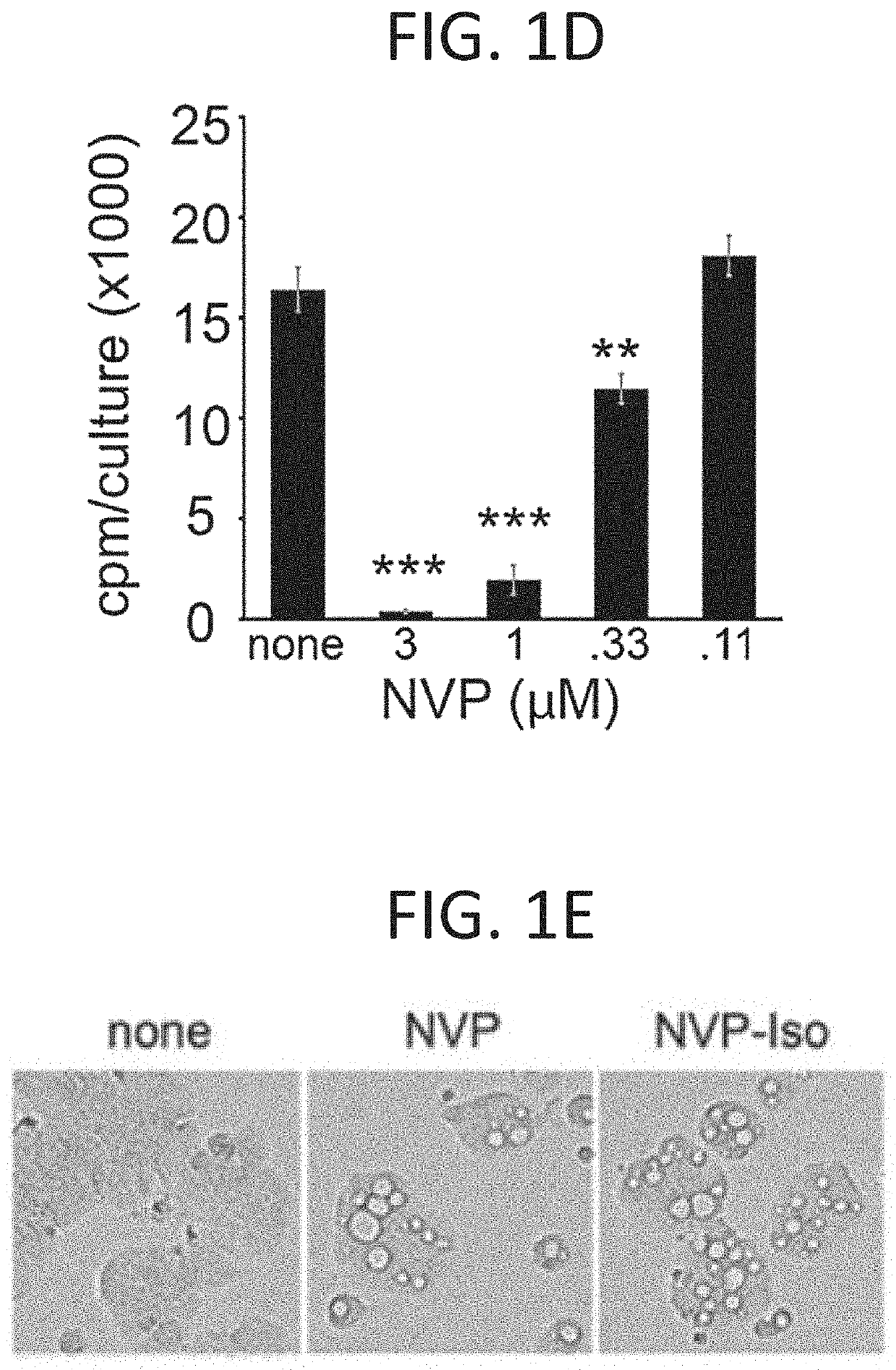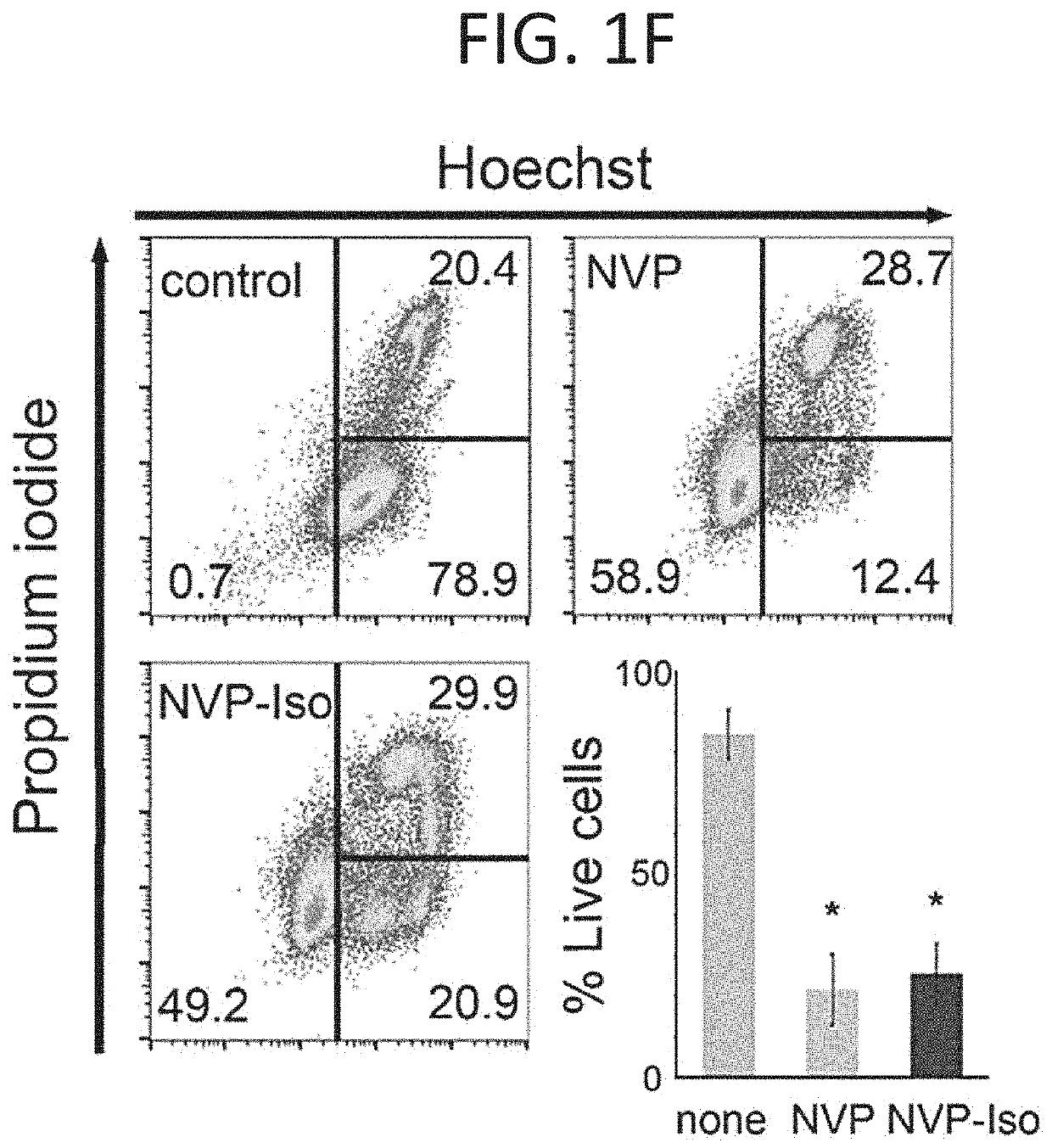Receptor tyrosine kinase inhibitors for treatment of protein kinase modulation-responsive disease or disorder
a kinase inhibitor and receptor tyrosine technology, applied in the field of receptor tyrosine kinase inhibitors, can solve the problems of less explored targets and poor clinical prognosis
- Summary
- Abstract
- Description
- Claims
- Application Information
AI Technical Summary
Benefits of technology
Problems solved by technology
Method used
Image
Examples
example 1
Evaluation of NVP-BHG712 and NVP-Iso
[0239]
[0240]NVP-BHG712 is a small molecular weight tyrosine kinase inhibitor identified by modeling the EphB4 kinase domain and optimization for inhibition of EphB4 phosphorylation in cells, which showed great selectivity and potency for EphB receptors among a large panel of receptor tyrosine kinase receptors (Chen et al., 2017; Martiny-Baron et al., 2010). In validation experiments, 1 μM NVP-BHG712 (NVP) and its regioisomer NVP-Iso (Troster et al., 2018) were found to reduce endogenous EphB4 tyrosine phosphorylation in the EphB4+ HT-29 cells (FIG. 1A), and specifically reduce EphB2 tyrosine phosphorylation induced by clustered EphrinB2-Fc in the EphB2+ Colo205 cells (FIG. 1B). Consistent with NVP specificity for targeting tyrosine kinase receptors. 1 μM NVP and 1 μM NVP-Iso did not reduce endogenous EphrinB2 phosphorylation in HT-29 cells FIG. 1C). EphrinB2 does not possess an intrinsic catalytic activity for signaling, relying instead on the rec...
example 2
Evaluation of Pyrazolopyrimidine and Triazine Derivatives
[0250]The binding affinities of the compounds to EphA2 were investigated by microscale thermophoresis (MST) (M. Jerabek-Willemsen et al., J. Mol. Struct. 2014, 1077, 101-113). The dissociation constants of compounds @1 and @3 determined by MST (towards EphA2) are in the low nanomolar range (KD=3-4 nM), whereas the corresponding NVPiso derivative @2 (KD=132 nM) shows 44-fold lower binding affinity towards EphA2. The derivatives @4 and @5 are less potent than the pyrazolopyrimidine derivatives @1 and @3, showing an increased KD of 86 and 225 nM, respectively (Table 2). The affinities of the triazine derivatives towards EphA2 cover a broad range from low nanomolar to micromolar. Correlation with the substitution patterns indicates that a nitrogen at position 3 (3-pyridyl or imidazole) of the triazine substituent may be important for generating affinity.
TABLE 2Overview of affinities of the synthesized derivatives @1-@14 towards Ep...
example 3
Compound Synthesis
[0257]For the synthesis of certain compounds, the following synthesis sequence was utilized: 1. Preparation of the precursors (benzamide and amino modified heterocycle substructures, FIG. 11) and 2. Amination using Buchwald-Hartwig conditions (see FIG. 12). The scope of triazine derivatives also was enlarged to asymmetric molecules using the well-established synthesis strategy of temperature controlled nucleophilic substitutions on cyanuric chloride (see FIG. 11),
[0258]Synthesis of the following precursors were performed according to earlier published procedures:[0259]5-Amino-1-methyl-1H-pyrazole-4-carbonitrile 19[1][0260]1-Methyl-6-(pyridin-3-yl)-1H-pyrazolo[3,4-d]pyrimidine-4-amine 18[1][0261]3-Amino-1-methyl-1H-pyrazole-4-carbonitrile 31[1][0262]2-Methyl-6-(pyridine-3-yl)-2H-pyrazolo[3,4-d]pyrimidin-4-amine 30[1][0263]3-Bromo-4-methyl-N-(3-(trifluoromethyl)phenyl)benzamide 22[1][0264]4,6-Dichloro-1,3,5-triazin-2-amine[3]
1. N-(3-Chlorophenyl)-4-methyl-3-((1-methy...
PUM
| Property | Measurement | Unit |
|---|---|---|
| volume | aaaaa | aaaaa |
| enantiomeric excess | aaaaa | aaaaa |
| enantiomeric excess | aaaaa | aaaaa |
Abstract
Description
Claims
Application Information
 Login to View More
Login to View More - R&D
- Intellectual Property
- Life Sciences
- Materials
- Tech Scout
- Unparalleled Data Quality
- Higher Quality Content
- 60% Fewer Hallucinations
Browse by: Latest US Patents, China's latest patents, Technical Efficacy Thesaurus, Application Domain, Technology Topic, Popular Technical Reports.
© 2025 PatSnap. All rights reserved.Legal|Privacy policy|Modern Slavery Act Transparency Statement|Sitemap|About US| Contact US: help@patsnap.com



